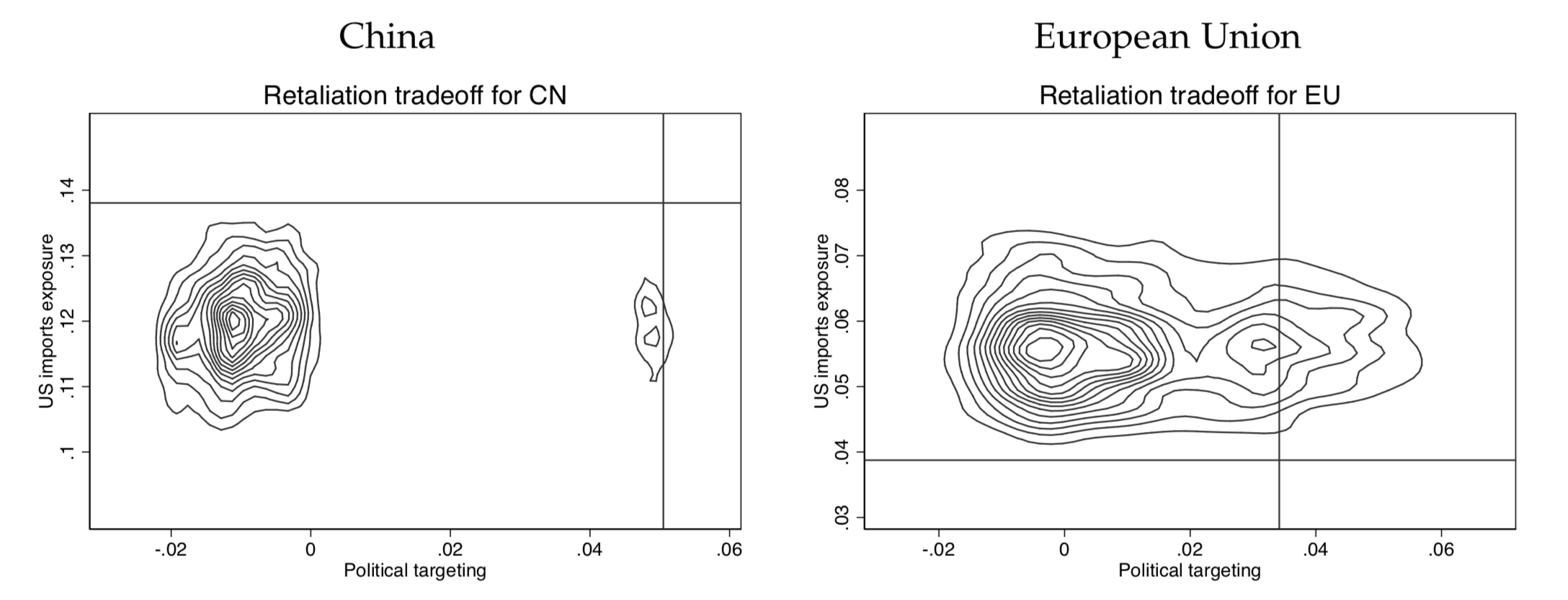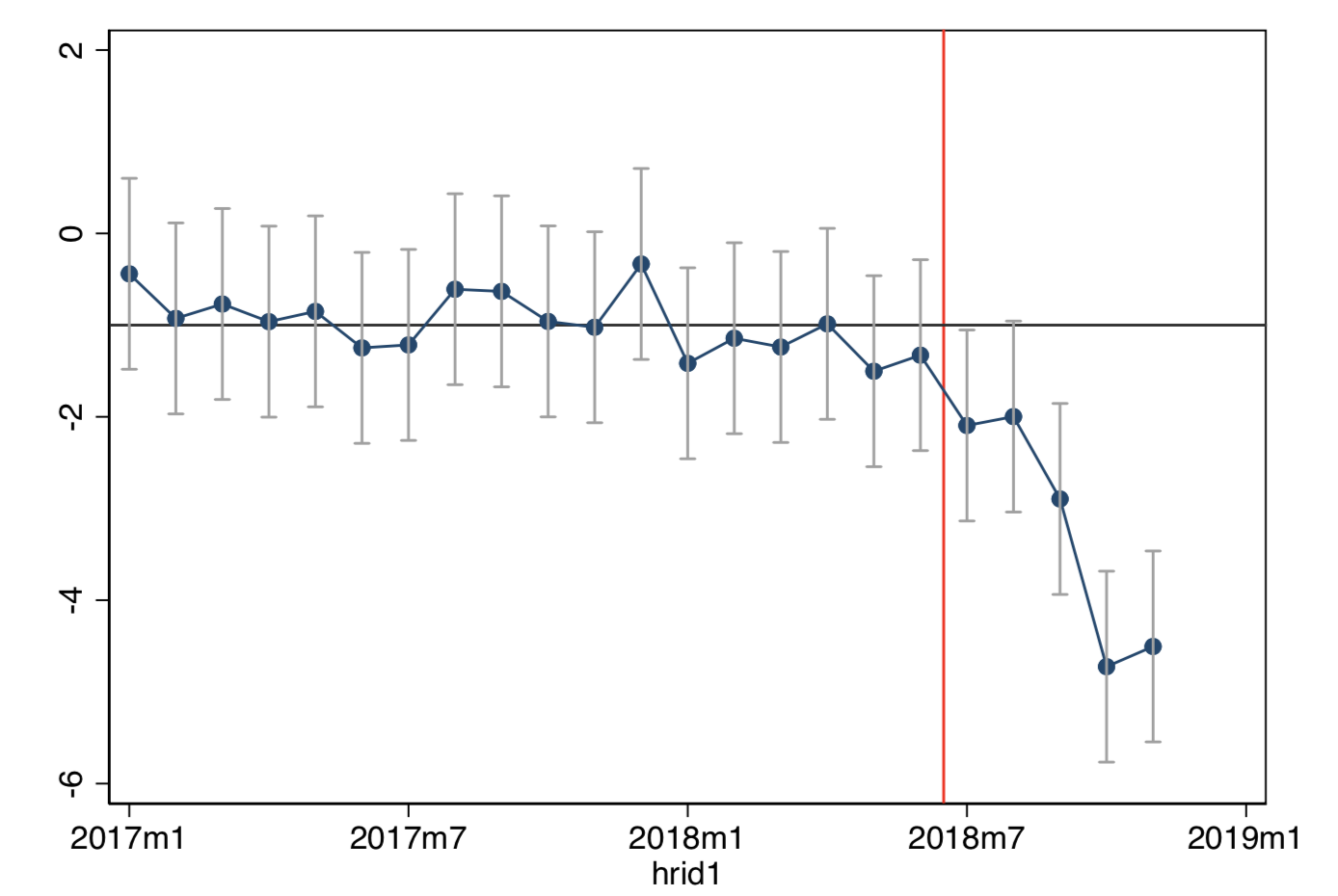Tariff retaliation is widely believed to be politically motivated. This column presents evidence that retaliation against the Trump administration’s tariff hikes seems to be systematically targeted against the Republican voter base. China appears to have been able to achieve a high degree of political targeting but likely harmed its own economy by targeting agricultural goods for which the US is a major supplier. The EU, on the other hand, appears to be more successful in navigating the trade-off. It also finds some evidence suggesting that Republican candidates fared worse in the mid-term elections in the US counties most exposed to retaliation.
Trade wars, as an instrument of trade and foreign policy, have returned to mainstream politics with the presidency of Donald Trump. Changes to US trade policy under a potential Trump administration were already allured to during the presidential campaign. Yet, it was only in March 2018 that various simmering disputes escalated into a full-scale trade conflict, most prominently involving China, Canada, Mexico, the EU, India, and Turkey. Following the announcement of tariffs on aluminium and steel, together with tariffs on Chinese imports, President Trump suggested that “[t]rade wars are good, and easy to win”.1
Economist widely agree that tariffs, while able to help certain individual industries, are not only harmful for trading partners but also constitute an act of self-harm (Bown 2004, Breuss 2004).2 In addition to the immediate negative impact of tariffs, the targeted countries may retaliate in accordance with WTO rules. In our new paper (Fetzer and Schwarz 2019) we carefully study the retaliation responses, in particular, by the EU, China, Mexico, and Canada.
Objectives of retaliation
The European Commission transparently states the objectives it aims to achieve in the context of trade disputes. EU Regulation 654, published in 2014, outlines three objectives for commercial policy measures in the context of a trade dispute:
“Commercial policy measures […] shall be determined on the basis of the following criteria, in light of available information and of the Union’s general interest:
a. effectiveness of the measures in inducing compliance of third countries with international trade rules;
b. potential of the measures to provide relief to economic operators within the Union affected by third country measures
c. availability of alternative sources of supply for the goods or services concerned, in order to avoid or minimize any negative impact on downstream industries, contracting authorities or entities, or final consumers within the Union”
In other words, trade policy should aim to change the trade policy of the opposing country, while minimizing harm to the own economy. In the case of Trump’s trade war, a possible way to affect the trade policy of the US would be to introduce a political cost for the Republican party.
It is this political dimension in the choice of the retaliation response, economists have not studied thus far – simply due to a lack of recent historical precedent. We fill this gap by investigating to what extent the retaliating countries or trading blocs managed to politically target their tariffs and if the targeting was effective in influencing political outcomes.
Anecdotally, the fact that retaliation is politically motivated is widely acknowledged. The retaliation response of most countries involved in the trade-dispute targeted US exports, such as bourbon whiskey, which is produced in Kentucky, the home state of Mitch McConnell’s (the Senate majority leader). China (as well as Mexico) targeted pork and soybeans, with the latter being one of the most important US agricultural export to China, which disproportionately affected Iowa, the home state of influential Republican Senate Agriculture Committee Member Senator Charles E. Grassley.
Tariff exposure and Republican electoral performance: County-level analysis
We formally investigate the political targeting of tariffs by construction a county-level measure of tariff exposure. Using this measure, we find that retaliation seem to be systematically targeted against the Republican voter base. Figure 1 plots share of exports of a county that were affected by tariffs dependent on the Republican vote share in that county in the 2016 presidential election. It is apparent that the counties with a higher Republican vote share were also more heavily targeted by retaliatory tariffs. This provides a first indication that tariffs were indeed targeted against Republicans.
Figure 1 Republican vote share and tariff exposure

Systematic regression evidence further highlights that targeting of tariffs was indeed sharply affecting counties where voters swung to support Donald Trump in the 2016 presidential elections (vis-à-vis the performance of the Republican presidential candidate in 2012). Interestingly, the degree of political targeting is associated with swings to Donald Trump in 2016 (vis-à-vis 2012), but not to areas that swung to support the Republican party candidates more broadly, for example, in House or Senate elections that were also held in 2016. This highlights that retaliation was sharply targeted to affect areas that markedly swung to Trump. This highlights a degree of sophistication in the design of the retaliation response. Yet, one key open question may be whether the retaliation response is optimal regarding the degree of political targeting?
Simulating alternative tariffs to assess extent of targeting
Countries can only meaningfully produce pressures by putting up tariff barriers against goods that are being imported from the US. A potential concern with the previous finding is that the observed targeting could be a mechanical result of the US export mix to a respective country. Consider for example the case of China, which is a major importer of soybeans from the US. Any retaliation bundle that includes soybeans will appear to politically target Republicans as soybeans are grown in Republican counties.
To assess this possibility, we compare the chosen goods basket to counterfactual simulated baskets that countries could have chosen. Ideally, all potential set of retaliation bundles could be simulated. Yet, it is computationally infeasible to derive all possible solutions to what is, in essence, a subset sum problem. In our paper, we use a sampling method to simulate alternative retaliation baskets. The simulation approach requires the sampled basket to match key moments of the actual basket: it should be similar in terms of size of the number of different products that are selected and it should affect a similar overall US export trade volume.
This sampling procedure allows to assess the degree of political targeting relative to the simulated alternative baskets. Motivated by the previously cited EU Regulation 654, we can also investigate whether the potential negative impact on the own economy is also considered when selecting goods for retaliation. To do so we construct a measure of the share of goods imported from the US for each of the retaliation baskets. Conceivably, retaliation should exclude products for which the US is the dominant supplier in order to mitigate domestic economic harm.
Figure 2 Trade-off in political targeting and exposure to US imports

Figure 2 plot the joint distribution of measures capturing the degree of political targeting on the horizontal axis as well as the average US market share in the imports affected on the vertical axis across the simulated alternative retaliation baskets. An ‘optimal’ retaliation basket bundle would lie in the lower right corner indicating both, a high degree of political targeting and, a low degree of likely economic harm to ones’ own economy. The vertical and horizontal lines indicate the values associated with the actually chosen retaliation bundle. The contour lines illustrate the distribution of the values associated with the individual simulated retaliation bundles and are informative about the likely choice set. The figure suggests that China was able to achieve a high degree of political targeting, but it likely caused harms to its own economy by targeting agricultural goods for which the US is a major supplier. The EU, on the other hand, appears to be more successful in navigating the trade-off, since it retaliated against goods for which the US is only a minor supplier while still achieving a modest degree of political targeting.
Are retaliatory tariffs effective?
Lastly, we investigate if retaliatory tariffs where successful in affecting political as well as economic outcomes. On the economic side, we document that exports hit by retaliatory tariffs declined significantly relative to exports that were not targeted by tariffs. Figure 3 visualizes this finding from a difference-in-difference design. Overall, our results suggest that each month $2.55 billion worth for US exports did not take place or were diverted as a result of retaliatory tariffs. We further show that also the export prices of US goods were negatively affected by the trade war. Together these results suggest that retaliatory tariffs were likely to have a negative impact on the local economy of affected counties.
More importantly, to understand if the tariffs were effective as a political instrument, we investigate whether the retaliatory tariffs were able to harm the electoral outcomes of the Republican party in the 2018 midterm election. We find some suggestive evidence that Republican candidates fared worse by between 1.4 and 2.7 percentage in counties most exposed to retaliation.
Figure 3 Impact of tariffs on US exports

References
Baldwin, R E (2004), “Openness and Growth: What’s the Empirical Relationship?”, in R E Baldwin and L A Winters (eds), Challenges to Globalization: Analyzing the Economics, Chapter 13.
Bown, C P (2004), “On the economic success of GATT/WTO dispute settlement”, Review of Economics and Statistics 86(3): 811–823.
Breuss, F (2004), “WTO Dispute Settlement: An Economic Analysis of Four EU US Mini Trade Wars”, Journal of Industry, Competition and Trade 4(4): 275–315.
Fetzer, T and C Schwarz (2019), “Tariffs and Politics: Evidence from Trump’s Trade Wars”, CEPR Discussion Paper 13579.
Grossman, G M and E Helpman (1994), “Protection for sale”, American Economic Review 84(4): 833–850.
Grossman, G M and E Helpman (1995), “Trade wars and trade talks”, Journal of Political Economy103(4): 675–708.
Maggi, G and A Rodriguez-Clare (1998), “The value of trade agreements in the presence of political pressures”, Journal of Political Economy 106(3): 574–601.
Endnotes
[1] See for example “Trump accuses China of ‘raping’ US with unfair trade policy”, BBC News, 2 May 2016.
[2] Given the large literature on the welfare enhancing effects of trade (Baldwin 2004), to offer an explanation why politicians nonetheless often favour tariffs, the work by Grossman and Helpman (1994, 1995) highlighted the influence of domestic politics and special interest groups on trade policy. In the same spirit, Maggi and Rodriguez (1998) argue that trade agreements could work as a commitment device for politicians against domestic interests.
[To read the original column, click here.]
Copyright © 2019 VoxEU. All rights reserved.
